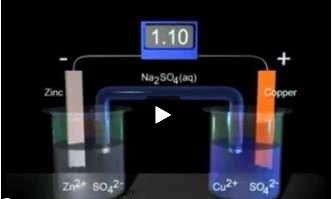CHEM 120 Lecture Notes - Lecture 22: Electric Current, Eflow, Voltmeter

Voltmeter:
- Electrochemical Cell: e-flow associated with a redox reaction routed through ext. circuit
- Galvanic/Voltaic Cell: produces current (electricity) from a spontaneous chemical reaction
that do work
- Electrolytic Cell: must be supplied with current to drive a nonspontaneous reaction
- Electrode: conducting substance that allows electrons to transfer between aq. phase & ext.
circuit, can be active/passive depending on redox rxn.
- Anode: electrode oxidation, [-] charge
- Cathode: electrode reduced, [+] charge
Salt Bridge: checks for over accumulation of charge; maintains neutrality
- over abundance of [+] charges on the anode, flow of Cl-
- over abundance of [-] charges on the cathode, flow of K+
- anions to anode, cations to cathode
Half Cell: compromised of container, electrolyte & electrode, where either oxidation/reduction
occurs
Passive Electrodes: do not take place in redox rxn
Cell Notation: oxidation half cell written on the left (anode), reduction half cell on the right
(cathode)
- m represents double line barrier on exam separating anode & cathode
- single line separates different phase
EMF: force that drives current
Cell Potential/Voltage Ecell – the difference in electrical potential between the anode & cathode
- Zinc has more oxidation potential; it can lose more electrons than the cell on the right
(pulling)
- Cu has more reduction potential; it wants to gain electrons (pushing)
V = J/C A = C/s
Cell Potential at Standard Conditions E0cell- only measured with respect to standard H electrode
Standard H electrode: made up of H gas (1 atm) & a passive platinum electrode
2H+ + 2e → H2 (1 atm) E0= 0V
(the sum of reduction – the sum of oxidation potential)
*Standard Cell Potential is always for the reduction reaction even if there is an oxidation present
+E0 → more likely to be reduced, strong oxidizing agent
-E0→ more likely to be oxidized, strong reducing agent
E0red = -E0ox
Changing the coefficients of the half reactions does not change the value of E0
find more resources at oneclass.com
find more resources at oneclass.com

26
CHEM 120 Full Course Notes
Verified Note
26 documents
Document Summary
Electrochemical cell: e-flow associated with a redox reaction routed through ext. circuit. Galvanic/voltaic cell: produces current (electricity) from a spontaneous chemical reaction that do work. Electrolytic cell: must be supplied with current to drive a nonspontaneous reaction. Electrode: conducting substance that allows electrons to transfer between aq. phase & ext. circuit, can be active/passive depending on redox rxn. Salt bridge: checks for over accumulation of charge; maintains neutrality. Over abundance of [+] charges on the anode, flow of cl- Over abundance of [-] charges on the cathode, flow of k+ anions to anode, cations to cathode. Half cell: compromised of container, electrolyte & electrode, where either oxidation/reduction occurs. Passive electrodes: do not take place in redox rxn. Cell notation: oxidation half cell written on the left (anode), reduction half cell on the right (cathode) M represents double line barrier on exam separating anode & cathode single line separates different phase.


